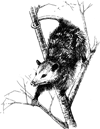Vertebrate Pest Conference Proceedings collection
Date of this Version
2-17-1994
Abstract
Economic losses caused by herbivores and other species that inflict damage by browsing or gnawing are substantial. Because lethal approaches to damage reduction are not always practical or desirable, there is an increase in interest in the development of alternative, non-lethal technologies. Repellents may provide a feasible alternative. Here, we present recent studies of three repellent types: 1) anthranilate derivatives (e.g., methyl anthranilate), 2) predator scents (e.g., coyote urine), and 3) bittering agents (e.g., denatonium saccharide). Anthranilate derivatives and predator odors both appear to be promising repellents. Avoidance of the former substances is based on irritant volatiles, and anthranilates may be especially beneficial when the aim is to prevent gnawing damage. Predator odors may be most applicable for protection of vegetation. The effectiveness of these substances appear to be based on the presence of highly volatile, light molecular weight sulfur compounds. Unlike anthranilates or predator odors, bitter substances are largely ineffective as repellents for herbivores.

